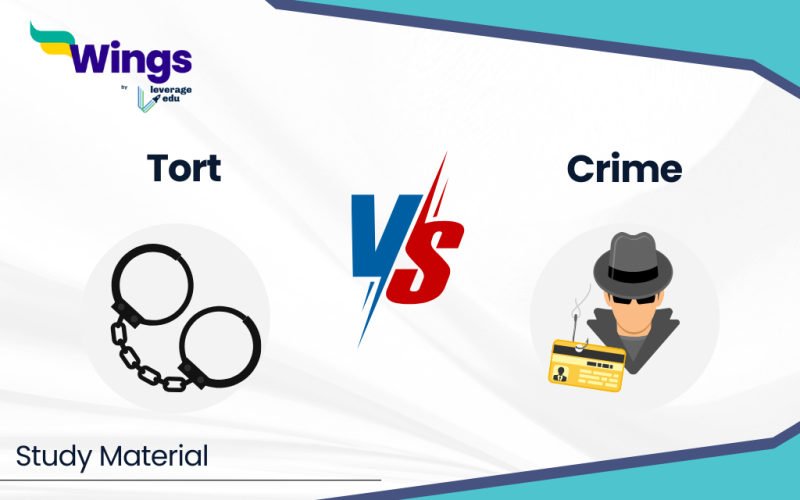Within the legal system, there are two separate concepts: crime and tort, which are generally misunderstood. The difference between a tort and a crime is that a tort is any civil wrong that harms or injures someone else or their property and may give rise to a claim for damages in court. A crime, on the other hand, is when someone breaks a law and faces consequences from the government. Crimes can be anything from small-time offences like parking tickets or small-time theft to more serious ones like fraud or murder.
Key legal principles must be understood to comprehend the legal system. Two key phrases that come up frequently in legal debates are “crime” and “tort.” Although they both include wrongdoing, their nature, outcomes, and legal processes are not the same. The purpose of this article is to examine the difference between a crime and a tort, and understand their importance within the legal system.
Table of Contents [show]
What is a Tort?
A tort is an unfair act committed against someone that results in harm to them and grants them the right to file a lawsuit in a court of law. The court has the authority to determine unliquidated damages in tort proceedings. The key components of this concept are explained below in order to make it simpler:
Wrongful Act: The basis of any tort is a wrongful act. It must be demonstrated that the defendant violated the duty of care that was owed to the victim. This violation may be the consequence of an action taken or an inaction taken.
Legal Damages: Anyone who proves that the defendant caused his or her harm may seek a certain amount of money in compensation. An injury, as defined by law, encompasses more than just physical harm, as it does in normal conversation. It denotes the violation of any individual’s rights.
Legal Remedies: In a court of law, an individual may be able to pursue legal remedies. Everyone has the right to pursue unliquidated damages, or compensation for losses that were not expected. Compensation varies depending on the circumstances of each instance.
Tort law is not governed by any particular statute or law in India. In India, torts have typically evolved as a result of precedents.
Also Read: What is the Difference Between Forward and Future Contract: Complete Details
What is a Crime?
When an act of harm is committed against the community, state, or society as a whole rather than just one person, it is considered a crime and is penalised by the state. The State’s laws restrict these behaviours. Crimes include things like rape, theft, and murder. This contrasts with a tort, which is typically directed more at a specific person. Mens Rea and Actus Rea are the two components that aid in the determination of a crime. The following is an explanation of these two factors:
Mens Rea: This shows the intention to commit a crime. This Latin phrase literally means “guilty mind.” It is the purpose of committing a crime or the state of mind. This is neither an accident or an instance of severe negligence; rather, the crime is committed by someone intending to cause harm.
Actus Reus: This is a criminal act performed with the intention of committing a crime. It is crucial to remember that a crime does not necessarily occur merely because someone intends to do it. The crime must actually be committed, or steps must be taken to commit it. If an act only satisfies one of the criteria listed above, it cannot be considered a crime. For an act to be considered a crime, both components must be present.
Difference between Tort and Crime
The definitions of tort and crime are different in both civil and criminal law. They cover a wide range of legal action, remedies, and consequences. The primary differences between a crime and a tort are as follows:
| Definition | A civil wrong that results in damage or injury to someone else or their property and gives rise to a compensation claim in court. | An offence of the law that is deemed a crime against society at large and is subject to government punishment. |
| Seriousness | Comparatively minor wrongs are called civil wrongs and classified as private wrongs. | More serious wrongs are classified as crimes and are regarded as public wrongs. |
| Court | Since a tort is regarded as a private wrong, the person who was harmed must bring a lawsuit in civil court on their own behalf. | A criminal complaint is submitted to the appropriate court. |
| Objective | The goal is to reimburse the plaintiff for the damages he sustained. | The objective is to punish the accused if found. |
| Compromise | Compromise is always possible. | Except in certain cases, compromise cannot happen. |
| Nature of Law | The law of torts is uncodified. | Crime law is a defined legal system. Every nation has a criminal law that outlines offences. |
| Burden of Proof | The plaintiff must prove their case by a preponderance of the evidence (more likely than not). | The prosecution must prove their case beyond reasonable doubt (almost certain). |
| Remedy | Monetary damages. | Fines, imprisonment, probation, etc. |
| Examples | Negligence, product liability, defamation, etc. | Murder, theft, assault, drug possession, etc. |
Examples of Tort
- With a hot mug of coffee in hand, X was returning to his office from lunch when he tripped and fell over Y. His steaming coffee consequently spilled all over Y. Because X owed Y a duty of care and there has been a breach, X can be held negligently responsible for Y.
- A was strolling aimlessly with his headphones on. A discovers after a while that he has invaded someone else’s property by going through the front garden. A is the one who trespassed.
Examples of Crime
- Z and X are competitors. One day, X grabs a knife, approaches Z, and fatally stabs him. X has killed someone.
- B abruptly grabbed hold of A’s pocketbook while she was walking, to snatch it and run off with it. B is the thief.
Also Read: What is the Difference Between Contract and Agreement? Complete Details
Advantages of Tort
A few of the advantages of tort are:
- Gives people a legal basis within which to pursue damages for injuries or losses they have experienced.
- Holds people responsible for their wrongdoings, which contributes to the preservation of societal order.
- Promotes conscientious conduct and adherence to care standards.
- Enables victims to obtain financial recompense and restore their financial situation.
- Permits the settlement of conflicts through civil litigation, which has the potential to be more affordable and accessible than criminal processes.
Advantages of Crime
A few of the advantages of crime are:
- keeps social order in place by discouraging people from acting illegally.
- Safeguards people’s safety and rights in society.
- Gives victims of criminal offences a sense of closure and justice.
- Fosters an attitude of accountability and taking ownership of one’s actions.
- Permits the use of suitable sanctions and programmes to facilitate the rehabilitation and reintegration of offenders into society.
Related Posts
FAQs
The disadvantage of a crime is: Criminal trials may be drawn out, complex, and expensive for the accused and the state.
The disadvantage of a tort is: It’s possible that monetary damages won’t compensate for the psychological, emotional, or bodily suffering.
Indeed, some behaviours, like violence or fraud, can result in both criminal and civil liability (tort).
This was all about the “Difference between Tort and Crime”. For more such informative blogs, check out our Study Material Section, you can learn more about us by visiting our Indian exams page.
 One app for all your study abroad needs
One app for all your study abroad needs















 45,000+ students trusted us with their dreams. Take the first step today!
45,000+ students trusted us with their dreams. Take the first step today!
